by Uri Marcus
Most Gentile Christians wouldn't bother to speculate about the time when Yeshua (Jesus) was born. They celebrate it on December 25th even though they may suspect that there is no Biblical basis for choosing that date. However, there are many Messianic Believers who, from a Jewish perspective, are convinced that the time of year when Yeshua was really born was at the Succot (the Feast of Tabernacles). Taking into account certain Jewish customs and traditions, and applying them to the biblical birth narrative, it's not difficult to calculate and arrive at this season, known as "the season of our Joy."
While there is quite a wide consensus of opinion that Yeshua was born at some time during the High Holy Days of Rosh Hoshanna (New Year), Yom Kippur (Day of Atonement), or Succot (Tabernacles), the timing can be narrowed down to Succot, in the opinion of this author, because of the abundance of historical and traditional associations which surround it. It should be noted that all of these festivals normally occur in the Autumn, or during the September or October time-frame, but it varies from year to year because the Jewish calendar is based on the cycles of the moon and doesn't track with the Gregorian calendar.
The calculation of the time of Yeshua's birth begins with Z'chariyahu (Zechariah), the father of Yochanan (John) the Baptist. According to Luke 1:5 he was a priest of the order of Aviyah. He was performing his duties, burning incense in the Beit HaMikdash (Temple), when an angel appeared and said his wife Eli-Sheva would conceive and bear a son, and he would be called Yochanan (John).
The order in which the priestly families performed their duties is given in 1 Chronicles 24:7-18. According to the Mishnah, the cycle begins on the first Shabbat (Sabbath) of Nisan, and each family of priests would minister in turn for one week. Since there are 24 families, each family would minister about twice a year. The cycle would be delayed slightly because all priests, regardless of their families, were required to be at the Beit HaMikdash (Temple) for the three festivals of Pesach (Passover), Shavu'ot (Pentecost) and Succot (Tabernacles).
The family of Aviyah was eighth in line, so Z'chariyahu would have had his first period of duty during the Jewish month of Sivan (about June) and his second period during the month of Kislev about six months later. There is no way of knowing for sure which period of duty is referred to in Luke's Gospel, but if it is surmised that it is the first period we get some very interesting results.
Z'chariyahu finished his first period of duty about the middle of Sivan. Because of his unbelief, G-d struck him dumb. Nevertheless, he went home to his wife and she became pregnant. Count off 40 weeks, the usual period of gestation, and we get to the month of Nisan the following year. Beginning on the 14th of Nisan, and lasting for eight days, we have the festivals of Pesach (Passover), Matzot (unleavened bread) and Bikurim (First Fruits), which are all occur in the spring. This raises the distinct possibility that Yochanan the Baptist was born at Pesach, which coincides with the Jewish expectation that Eliyahu (Elijah) would come at Pesach. It has always been our custom to put an extra cup of wine on the table at Pesach, in the hope that Eliyahu will come and drink it.
If Yochanan the Baptist was born at Pesach, Yeshua must have been born during the fall feasts, and most probably at Succot. In Luke 1:26 and 36 we are told that Yeshua was six months younger than Yochanan.
When the decree went out for everyone to go to their home town to be registered, Yosef and Miriam set off for Beit Lechem (Bethlehem). They would have set out in good time, before Miriam was fully 40 weeks pregnant, because she wouldn't want to be jogged into childbirth while riding on a donkey. Besides, they would have wanted to complete the journey before Rosh Hoshanna, which is two weeks before Succot.
We are given a clue about the time of the birth by the angel who appeared to the shepherds and said "Fear not. For, behold, I bring you good tidings of great joy, which shall be to all people.". (Luke 2:10). There are actually two clues here. Succot is known as "The Season of our Joy", and it is also known as the "Festival of the Nations (or Gentiles)". The angel was actually giving them a greeting for the Festival of Succot. This is the only festival where the nations are positively encouraged to participate with negative results if they do not. (Z'chariyahu 14:16-19). In addition, the narrative indicates that it was shepherds to whom the angels delivered their message, which is interesting in that for thousands of years Jewish literature ascribes a tradition known as "Ushpizin", only to Succot, and it is practiced even to this day.
After entering the Succah, and reciting certain prayers, the ceremony of Ushpizin bids us to partake in the privilege of inviting and welcoming the "Sh'kinah" ) G-d's Presence) and the seven "faithful shepherds" who enter the succah with us as exalted guests. These guests come to observe how their descendants FULFILL the mitzvah (commandment) of the Succah, in which they dwell under G-d's protection, in accordance with what G-d had promised in the Torah. These seven faithful shepherds of Israel are: Avraham, Yitzchak, Ya'acov, Yosef, Moshe, Aharon, and Melech (King) David. Back in the Luke narrative, though the text does not specify "seven" shepherds who went to visit Meriam, there seems to be a hint, when one reads between the lines. Moreover, the purpose of their visit is recorded to be very similar with that of the Ushpizin, in which the text states that it was to "see this thing that had happened, which the Lord has told us about." (Luke 2:15).
Likewise, during Succot, Jewish families today in Israel construct a flimsy shelter called a "Succah", made of loosely assembled walls and a leafy overhead covering. In the Succah, we eat or sleep. This is a reminder to us that we were completely dependent on G-d as we wandered for forty years in the desert after departing from Egypt and were led by "a pillar of cloud by day, and a pillar of fire by night." Because of this experience, we recall that "G-d is with us" (Emmanu-El).
In this same narrative in Luke 2 regarding the Shepherds to whom an angel of the Lord appears, note that the text says that they were "watching over their flocks, AT NIGHT." The angel brings them a message that their Messiah was born in the town of David, during that day which had just passed to night. This message was accompanied by the appearance of a great heavenly host, praising G-d. When we consider the seasons in Israel, and the weather patterns, one might ask "What is the latest time of year in which shepherds would still be outside with their flocks in the Judean hills, AT NIGHT?" November through February are far to cold in Israel to be doing this kind of activity. The answer of course points to the end of October, at the latest, for temperature reasons alone. Depending of the Hebrew calendar in any given year, as mentioned above, Succot always falls in the September-October time frame, when the weather is still warm and pleasant outside, especially AT NIGHT. For these reasons, and many others not documented here, we think Yeshua is very likely to have been born at Succot.

And so, the birth of Yeshua at Succot fulfills another prophecy: "The virgin will be with child and will give birth to a son, and they will call him Emmanu-El - which means, "G-d is with us". (Matt. 1:23, quoting from Yishaiyahu (Isaiah) 7:14).
If this is not enough, we also have to consider the type of dwelling in which Yeshua was born. Had it not been for the inconvenience caused by the census, he would have been born in a house like all other children. But he wasn't, he was born in a type of Succah where servants of a household slept, or where they kept sheep and cattle. Luke uses the Greek word for "manger" but because Yeshua was Jewish, and it was most likely the festival of Succot, the text probably describes a Succah. This would make sense since we know that Yeshua would fulfill every aspect of Torah from his birth until his death. The link here is directly to commandment in VaYikrah (Leviticus) Chapter 23, verse 42, "Live in Succot for seven days: All native-born Israelites are to live in Succot so your descendants will know that I had the Israelites live in Succot when I brought them out of Egypt. I am the LORD your G-d."
Yochanan, in his Gospel narrative of Yeshua's birth, confirms this truth when he indicates that G-d had come to earth to dwell with (and serve) humanity. We read in Yochanan (John) 1:14 about how "The Word became flesh and made his dwelling (Tabernacled) among us," which is a clear and obvious reference to Succot.
Eight days later, according to Luke 2:21, Yeshua was circumcised. Miriam would still have been ceremonially unclean for 33 days after the Yeshua's birth, in accordance with ViYikrah (Leviticus) 12. Owing to her requirement to present a purification offering at the Beit HaMikdash (Holy Temple) in Yerushali'im (Jerusalem) after this period, she would most likely have remained in Beit Lechem, just a short distance from Yerushali'im.
If the day of Yeshua's birth was the first day of Succot, then the day of his circumcision would be the eighth day after Succot which, in accordance with Torah is also day of sacred assembly. (ViYikrah [Leviticus] 23:39). On this day, called "Shemini Atzeret," or "the Eighth day of Solemn Assembly" and later called "Simchat Torah" or "Rejoicing in Torah," we complete our annual cycle of Torah readings and start again from Bereshit (Genesis). It is considered to be a time of "fulfillment" of the Torah and also a new beginning for it, in our lives, since Torah is never abandoned. This indeed would seem to be a fitting holiday for Yeshua's circumcision and dedication before G-d, since He came to set the Torah on a firm foundation by correctly interpreting it and fulfilling it (i.e., becoming the goal to which the Law and the Prophets pointed), thereby making a way to renew the Torah in our lives. (Matt. 5:17-19).
When the days of Miriam's purification were over, they would have then returned back to Natzeret (Nazareth) in the Galil (Luke 2:39). But each year, and in accordance with the required pilgrimage commandments in Torah, Yosef and Meriam went up to Yerushali'im for Pesach. (Luke 2:41).
During one of these visits, probably when Yeshua was about two years old, they went to Beit Lechem and stayed, not in a succah or stable this time, but in a house. (Matt. 2:11). They were visited there by the Magi, and then had to flee to Egypt to escape from Herod because he was killing all the male children two years old and under.
And so, by starting from Z'chariyahu, the father of Yochanan the Baptist, and his first period of duty in the Temple, and doing a few simple calculations, we discover that the Jewishness of the Gospel becomes profoundly evident, giving new import to many passages of Scripture previously misunderstood.
What then should we do now? Should Christians continue observing Christmas on December 25th (which incidentally is entirely pagan in its origins), or are we going to begin recognizing our Hebraic roots and understanding the purpose of the feasts which the Father in His wisdom has bestowed. He has given us an inheritance, that in them we might be in rehearsal for the day our King returns, for then, we shall all celebrate the feasts together with Him.
Some may belief that it does not matter when we celebrate the birth of the Mashiach; it can be any of the twelve months of the year! What is important is to celebrate His birth.
But this defeats the importance of Messianic prophecy and fulfillment! The birth of Yeshua at the Festival of Succot was for prophetic reasons foreshadowing the Torah, the goal to which it pointed, the seventh millennium and the kingship of Mashiach from Yerushalayim. These are important pictures to treasure in our hearts! If it is important enough to G-d that He would cause Yeshua's birth AND coronation as King to takes place at an appointed season (mo'ed z'manim) on the Jewish Calendar, then it should be important to us, regardless of the world's traditions. Therefore, we should heed the words of Rabbi Sha'ul (Paul) who quoting the Father, urged the Church at Corinth to:
..."come out from them and be separate," says the Lord. "Touch no unclean thing, and I will receive you. I will be a Father to you, and you will be my sons and daughters," says the Lord Almighty.
If we do this (and we don't have to become Jewish to do it) we will be creating the conditions in which Z'chariyahu 14:16-19 can be fulfilled. People will say "Since we are celebrating the birth of Yeshua at Succot, why not do it in Yerushali'im?". Why not indeed?
Many peoples will come and say, "Come, let us go up to the mountain of the LORD, to the house of the G-d of Ya'acov. He will teach us his ways, so that we may walk in his paths." The law will go out from Tzion, the word of the LORD from Yerushali'im. -- Yishaiyahu (Isaiah 2:3)
In Israel it's impossible to miss these festivals, but for the benefit of those in the Diaspora, the 1999 dates are:
Rosh HaShana (Festival of Trumpets) Fri Eve 10 September
Yom Kippur (Day of Atonement) Sun Eve 19 September
1st Day of Succot (Feast of Tabernacles) Fri Eve 24 September 8th
Day of Assembly (Shemini Atzeret) and
Simchat Torah (Rejoicing in the Torah) Fri Eve 01 October
The Jewish day begins at sunset which means, for example, Rosh Hoshanna begins at sunset on Friday Eve, 10 September and continues until evening on the 11th of September.
Uri Marcus
Adapted from various sources, including my brother's book "Signs In the Heavens" (by Avi Ben-Mordechai), available from him by calling 1-800-880-2656. Revised November 19, 1998.
Uri Marcus (former member)
The Nehemiah Trustees Covenant
Fund P.O. Box 44840
Haifa, 31447 Israel
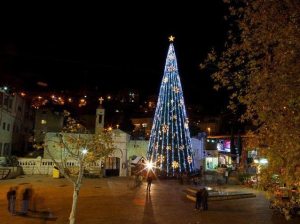



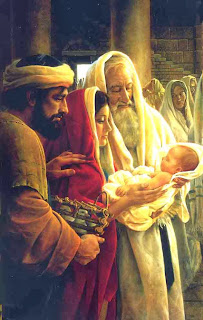








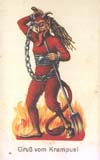 known by many names across the continent — Knecht Ruprecht, Certa, Perchten, Black Peter, Schmutzli, Pelznickel, Klaubauf, and Krampus. Usually seen as a classic devil with horns, cloven hooves and monstrous tongue, but can also be spotted as a sinister gentleman dressed in black or a hairy man-beast. Krampus punishes the naughty children, swatting them with switches and rusty chains before dragging them in baskets to a fiery place below.
known by many names across the continent — Knecht Ruprecht, Certa, Perchten, Black Peter, Schmutzli, Pelznickel, Klaubauf, and Krampus. Usually seen as a classic devil with horns, cloven hooves and monstrous tongue, but can also be spotted as a sinister gentleman dressed in black or a hairy man-beast. Krampus punishes the naughty children, swatting them with switches and rusty chains before dragging them in baskets to a fiery place below.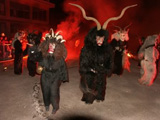 Krampus is celebrated on Krampusnacht, which takes place on the eve of St. Nicholas’ Day. In Austria, Northern Italy and other parts of Europe, party-goers masquerade as devils, wild-men, and witches to participate in Krampuslauf (Krampus Run). Intoxicated and bearing torches, costumed devils caper and carouse through the streets terrifying child and adult alike. Krampusnacht is increasingly being celebrated in other parts of Europe such as Finland and France, as well as in many American cities.
Krampus is celebrated on Krampusnacht, which takes place on the eve of St. Nicholas’ Day. In Austria, Northern Italy and other parts of Europe, party-goers masquerade as devils, wild-men, and witches to participate in Krampuslauf (Krampus Run). Intoxicated and bearing torches, costumed devils caper and carouse through the streets terrifying child and adult alike. Krampusnacht is increasingly being celebrated in other parts of Europe such as Finland and France, as well as in many American cities.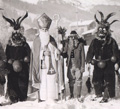 The European practice of mummery during the winter solstice season can be traced back tens of thousands of years. Villagers across the continent dress up as animals, wild-men and mythic figures to parade and perform humorous plays. This ancient guising and masking tradition continues to this day as the primary source for our modern Halloween with its costumes, trick-or-treat, and pagan symbolism. Among the most common figures in these folk rituals were Old Man Winter and the horned Goat-Man — archetypes now found in the forms of Saint Nick/Santa Claus, and the Devil (‘Old Nick’), aka Krampus.
The European practice of mummery during the winter solstice season can be traced back tens of thousands of years. Villagers across the continent dress up as animals, wild-men and mythic figures to parade and perform humorous plays. This ancient guising and masking tradition continues to this day as the primary source for our modern Halloween with its costumes, trick-or-treat, and pagan symbolism. Among the most common figures in these folk rituals were Old Man Winter and the horned Goat-Man — archetypes now found in the forms of Saint Nick/Santa Claus, and the Devil (‘Old Nick’), aka Krampus. 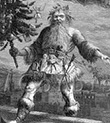 In 19th century New York City an American St. Nick emerged in the form of Santa Claus. Although based on the Dutch Saint Nicholas, Santa incorporated more elements from pagan winter solstice customs. He relinquished his white bishop garb for a red suit, traded his horse and staff for a sleigh and reindeer, and moved his franchise to Christmas Eve.
In 19th century New York City an American St. Nick emerged in the form of Santa Claus. Although based on the Dutch Saint Nicholas, Santa incorporated more elements from pagan winter solstice customs. He relinquished his white bishop garb for a red suit, traded his horse and staff for a sleigh and reindeer, and moved his franchise to Christmas Eve. Santa also tried to take over the dark companion’s job of punishing the naughty, but his New World temperament was apparently unsuited for the task. As Santa neglected and abandoned his punishing duties, American kids lost all fear of Santa and his lumps of coal. Thankfully, in the 21st century, Krampus has arrived in this land of spoiled and dissatisfied children to pick up the slack.
Santa also tried to take over the dark companion’s job of punishing the naughty, but his New World temperament was apparently unsuited for the task. As Santa neglected and abandoned his punishing duties, American kids lost all fear of Santa and his lumps of coal. Thankfully, in the 21st century, Krampus has arrived in this land of spoiled and dissatisfied children to pick up the slack.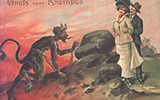 While Santa Claus expanded shop and sold products in mid-1800s America, the holiday card craze exploded in Europe.
While Santa Claus expanded shop and sold products in mid-1800s America, the holiday card craze exploded in Europe. In Austria and other parts of Europe, countless season’s greeting cards featured Krampus, often emblazoned with the phrase “Grüß Vom Krampus” (Greetings from Krampus). While the lurid images are suffused with a modern sense of the comic and the surreal, they still resonant with mythic power and primordial horror.
In Austria and other parts of Europe, countless season’s greeting cards featured Krampus, often emblazoned with the phrase “Grüß Vom Krampus” (Greetings from Krampus). While the lurid images are suffused with a modern sense of the comic and the surreal, they still resonant with mythic power and primordial horror. 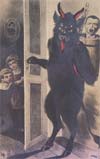 And with Krampus representing the naughty side of the season, the sexy subtext is hard to ignore in these often very cheeky cards. A century later, the brilliance of these magnificent works of pop art is now gaining global recognition.
And with Krampus representing the naughty side of the season, the sexy subtext is hard to ignore in these often very cheeky cards. A century later, the brilliance of these magnificent works of pop art is now gaining global recognition.



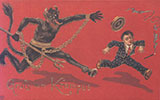 A new appreciation of ancient traditions that smoulder in the dark recesses of holiday revelry continues to rise around the world. Krampus, with his horns, hoove and tongue, embodies this revived spirit of the Xmas season!
A new appreciation of ancient traditions that smoulder in the dark recesses of holiday revelry continues to rise around the world. Krampus, with his horns, hoove and tongue, embodies this revived spirit of the Xmas season!